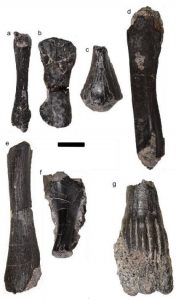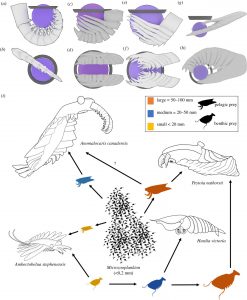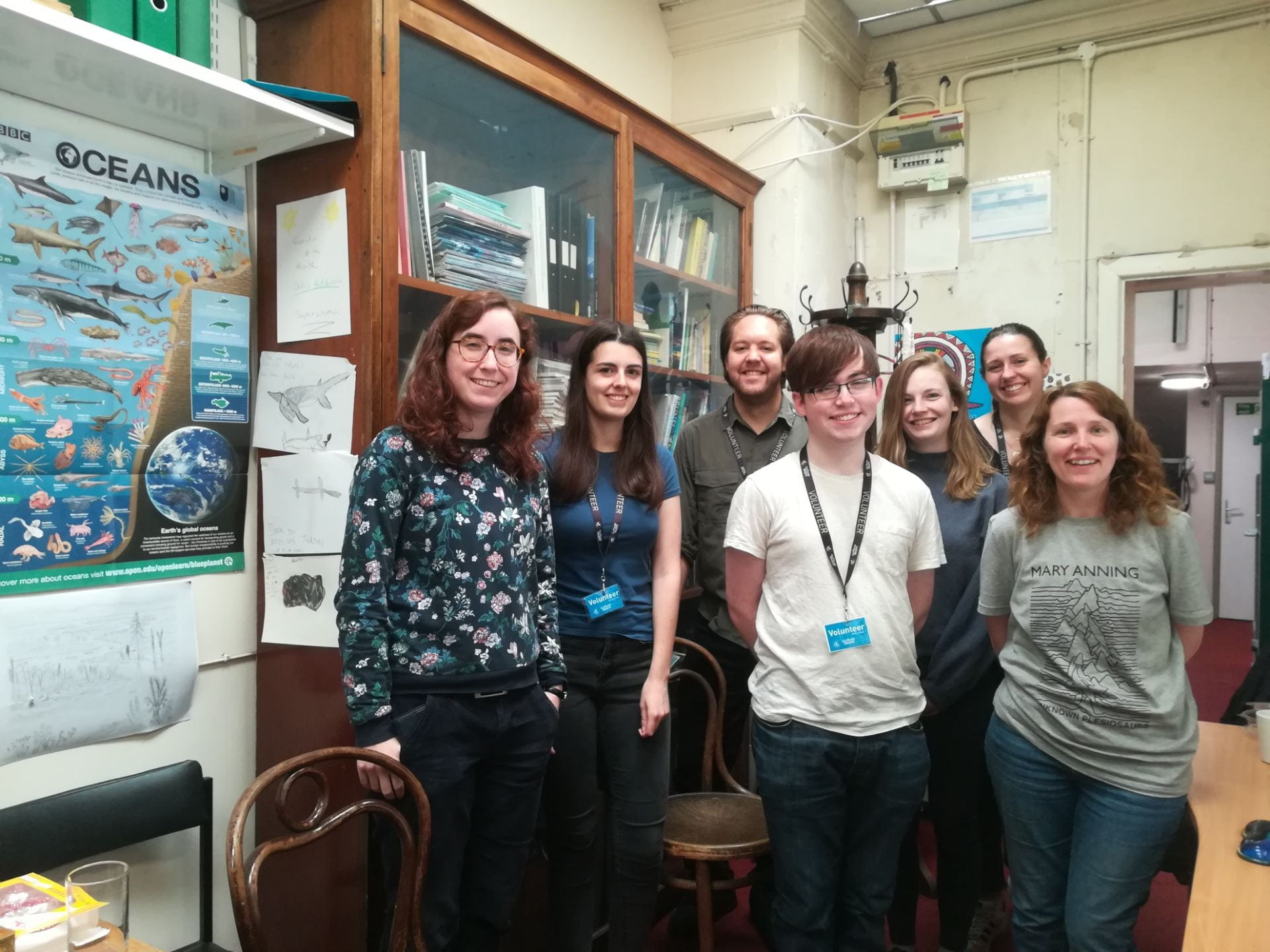This week Palaeobiology MSc students have been presenting the initial findings of their research projects to the rest of the research group. Here you can see a few of the title slides from the presentations.
Category: Current students
Grace Kinney-Broderick publishes paper on tuatara-like sphenodontian from the Early Jurassic
The tuatara, Sphenodon punctatus, has often been called a ‘living fossil’ because it is the sole species of its lineage, having been separate from the squamates (lizards and snakes) since the Triassic. Indeed, diverse Mesozoic sphenodontians show the group was once much more diverse and successful than it now is.
Now, MSc student Grace Kinney-Broderick is a co-author on a paper in Scientific Reports about about a new sphenodontian from the Early Jurassic of Arizona, USA, called Navajosphenodon sani. The new fossil is represented by a nearly complete articulated skeleton and dozens of upper and lower jaws, spanning a range of developmental stages. Phylogenetically it sits right beside the modern Sphenodon, close to the Early Jurassic Cynosphenodon from Mexico, indicating a lineage that has remained anatomically almost unchanged for nearly 200 million years.

The work was conducted at Harvard University with Dr. Stephanie Pierce and Dr. Tiago Simões. Grace was completing her undergraduate BSc at Boston College during this time by working in collaboration with the Museum of Comparative Zoology. Grace comments, “I am a co-author on my first publication! I am beyond excited and so thankful to Dr. Pierce and Dr. Simões for the opportunity.”
[Right] Grace and the title page of her paper.
Harriet Williams publishes her summer project
Current MSc student has just published work from a project she did last summer before starting the degree programme. She was working on an example of the latest Triassic Rhaetian bonebed from a site near Gloucester, called Westbury Garden Cliff. This classic site had first yielded fossil reptiles and fishes as long ago as the 1840s, but had not received modern study.
 Harriet worked on specimens from Bristol City Museum as well as newly collected materials. During field work, Harriet noted large numbers of burrows and trails made by worms, clams, and king crabs. In fact, the king crab tracks and resting marks show that this had become a tidal zone, where the sea flooded in and out.
Harriet worked on specimens from Bristol City Museum as well as newly collected materials. During field work, Harriet noted large numbers of burrows and trails made by worms, clams, and king crabs. In fact, the king crab tracks and resting marks show that this had become a tidal zone, where the sea flooded in and out.
The Rhaetian Transgression flooded across Europe and brought with it sharks, bony fishes and marine reptiles. One of the most exciting finds from the site is the small marine reptile Pachystropheus. This slender reptile was less than a metre long, like a long-necked salamander, chasing fish through the shallow waters.
Harriet’s paper is published in Proceedings of the Geologists’ Association, and the University of Bristol also produced a press release.
Bristol MSc students publish their thesis work
As in previous years, we can report some fantastic publications by our MSc students: 11 papers in the leading international research journals. Full details are listed here.
The papers are based on the research projects students complete as part of the work for the MSc, and so represent 6-9 months of work. One paper, in leading US journal Science Advances, combines the work of three MSc students, Emily Carlisle, Melina Jobbins, and Vanisa Pankhania, in their study ‘Experimental taphonomy of organelles and the fossil record of early eukaryote evolution’. Each student carried out experiments on exceptional preservation of cellular components, and related this to what we see of some of the earliest fossils.
 Other papers include Natasha Howell’s project on aposematism in mammals, published in Evolution, Giacinto de Vivo’s study of function in the anomalocarids, giant Cambrian predators, and Karina Vanadzina’s study of developmental change in planktic foraminifera during a speciation event.
Other papers include Natasha Howell’s project on aposematism in mammals, published in Evolution, Giacinto de Vivo’s study of function in the anomalocarids, giant Cambrian predators, and Karina Vanadzina’s study of developmental change in planktic foraminifera during a speciation event.
The image (right) shows Giacinto De Vivo’s models of the feeding appendage of a giant anomalocarid, and a reconstructed Cambrian foodweb.
Bristol MSc students publish record number of papers
 Since the Bristol MSc in Palaeobiology began right back in 1996, we encouraged the students to aim high, and to publish their research projects. Since then, we have accrued over 160 publications from the formal research projects each student does. Most years, there are maybe 5–10 published papers, but in 2020, that number was 15.
Since the Bristol MSc in Palaeobiology began right back in 1996, we encouraged the students to aim high, and to publish their research projects. Since then, we have accrued over 160 publications from the formal research projects each student does. Most years, there are maybe 5–10 published papers, but in 2020, that number was 15.
The papers cover all fossil groups, from foraminifera to dinosaurs, and addressing themes in macroevolution, phylogeny, climate change, palaeoecology, and biomechanics. Read all the details here.
In fact, MSc students published 17 items in 2020, including a news item by Jack Cooper about his work on Megalodon, the largest shark, and Rachel Kruft Welton’s book, Practical R for Biologists.
These publications represent great achievements for the individual students; even turning a top-rated project into a paper that passes scrutiny of the leading international journals is a large task; each of these represents fantastic knowledge, intelligence and effort by each of the named students.
Rachel Kruft Welton publishes new book on R
It’s not often that a Masters student publishes a book, but Rachel Kruft Welton has just done that, as co-author of the bestselling Practical R for Biologists: An Introduction. The aims of the book are to work “through a set of studies that collectively represent almost all the R operations that biology students need in order to analyse their own data. The material is designed to serve students from first year undergraduates through to those beginning post graduate levels”.
 In fact, Rachel is an unusual student, in that she already has an MSc from Imperial College London and a PhD from the University of Birmingham, UK before qualifying as a teacher. She has been a professional biology and science tutor for nearly 20 years, including mentoring undergraduates as part of Birmingham University’s alumni scheme. Rachel has returned to academic research after raising two sets of twins. She hopes to continue where she left off.
In fact, Rachel is an unusual student, in that she already has an MSc from Imperial College London and a PhD from the University of Birmingham, UK before qualifying as a teacher. She has been a professional biology and science tutor for nearly 20 years, including mentoring undergraduates as part of Birmingham University’s alumni scheme. Rachel has returned to academic research after raising two sets of twins. She hopes to continue where she left off.
If you are interested in buying the book, go to https://uk.bookshop.org/books/practical-r-for-biologists-an-introduction/9781789245349.
MSc students volunteer at Bristol City Museum
Msc students regularly volunteer for projects at Bristol City Museum, which is next door to the School. This year the students are working to curate and catalogue the historic collections of E.T. Higgins – mostly Rhaetic material from the classic local site of Aust Cliff. The students are gaining invaluable curation skills from the Curator of Geology (and former MSc student) Debs Hutchinson.


